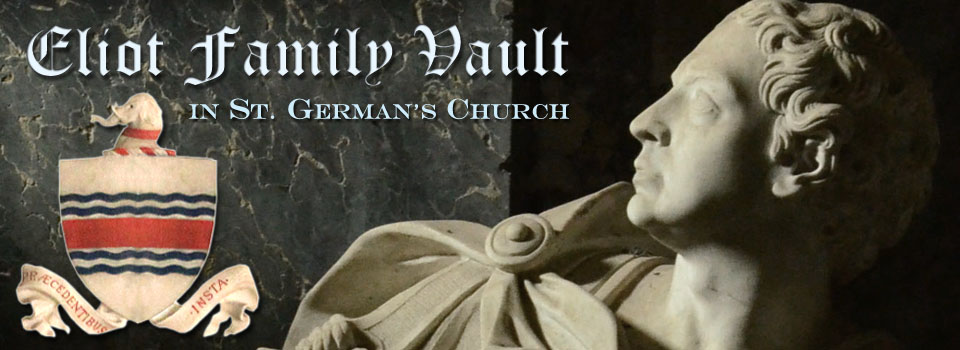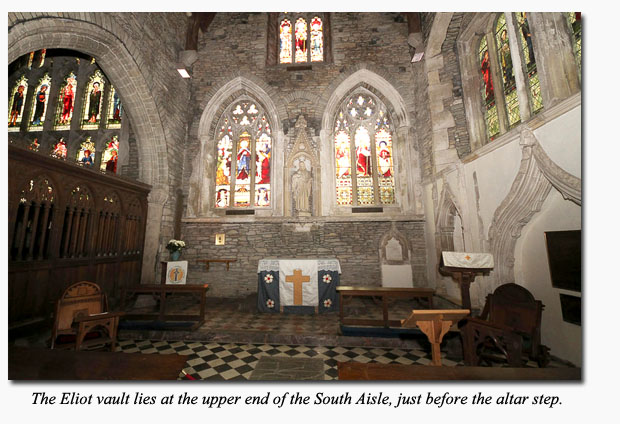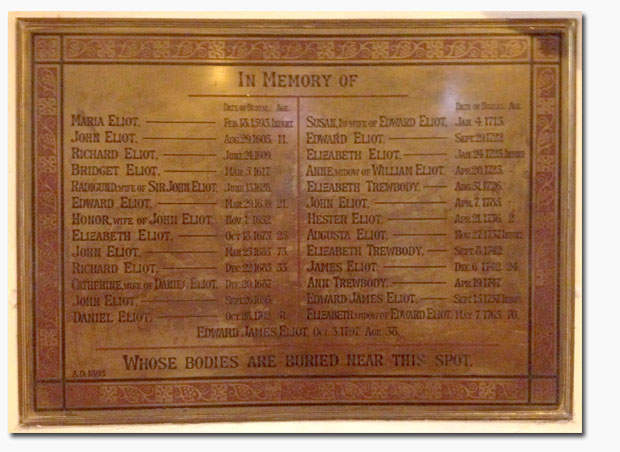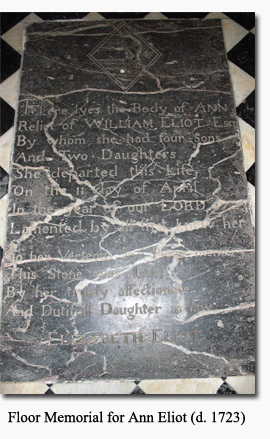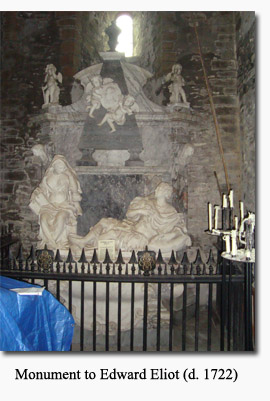The Eliot Family Vault in St. German's Church
Location and Age of the Vault
The ancient Augustinian Priory at St. Germans, Cornwall, came into the possession of the Eliot family in 1565. Included was a private burial vault below the church floor, situated at the upper end of the South Aisle in the Lady's Chapel. The Eliots buried in this vault through 1797, at which time it was declared "full", and Lord Eliot had a second family vault constructed in the new (now "old") churchyard (situated about a quarter of a mile from Port Eliot).
Historical References to the Vault
Written references to this first Eliot vault are few, which means that facts have been pieced together from random bits of information recorded over the last four hundred years. The earliest- known reference to this vault is the unfruitful request of Sir John Eliot's children, sent to King Charles in 1632, requesting permission to bring their father's body home for burial in the family vault. The next mention comes from Browne Willis (noted historian), when he wrote of the 1702 burial of his father-in-law, Daniel Eliot. The last known references to burials in this vault are found in 1797 newspaper announcements of the funeral of Edward James Eliot, son of the 1st Lord Eliot.
1890s Memorial Plaque at St. German's Church
Extensive renovation was carried out in the church at St. Germans between 1888 and 1898, at the completion of which a large bronze plaque was erected – in the Lady's Chapel – to the memory of members of the Eliot Family whose bodies were buried "near this spot". The identity of the compiler of the information on this plaque is unknown, but four recently-identified errors discovered on it, as well as haphazard record-keeping at St. German's Church, have made it less than simple to finalize the list of actual vault burials. Many rectors in other parishes made special notes when a burial had taken place in a vault, but not so at St. German's. If the Eliots ever kept a list of vault burials, it is now lost. Obviously, the compiler consulted more than just the incomplete parish registers, but what that extra something is is open to conjecture.
Of the twenty-seven burials listed on the plaque, two have incorrect ages, one is not a relative of the family (and would not have been in the vault), and one is not a real person (being a combination of three different parish records).
Error #1: John Eliot (buried 29 Aug 1603)
This is the second burial listed on the plaque, but there was, in fact, no John Eliot buried at that time. This fellow is a fictitious conglomeration of two actual St. German's burial records and one Christening record. The name itself is a faulty transcription of "John Escot", a man buried at St. German's on 5 Sep 1603. The burial date on the plaque, August 29th, is the date written in the parish register above that of John Escot, being the burial date of a woman named "Sibella Deble" (who was, by the way, the only burial on that day). The mistake in age shown on the plaque (stating that John was 11 years old at the time of burial) is just as easily explained. The informant searched, quite obviously, through pre-1603 Christening records for a John Eliot, found one baptised on 20 Apr 1592, and supposed it to belong to the John buried in 1603. Fortunately, the Christening date of Sir John Eliot (the famous Patriot) has been well-documented as having taken place at St. German's on 20 Apr 1592, and there are no other baptisms recorded for a John Eliot prior to 1603. This burial, as engraved on the plaque, is simply a mistake made by someone who was, perhaps, unable to read the old church records and/or unfamiliar with the history of Sir John Eliot.
Error #2: Edward Eliot (buried 29 Mar 1639)
This is the sixth burial on the plaque, the error being in the given age of twenty-one years. The Edward Eliot buried here was actually the days-old infant grandson of Sir John Eliot (and son of John & Honor Eliot), who had been baptised at St. German's on 28 Mar 1639 and buried there the following day. Again, whoever read the parish registers, when collecting the information for this plaque, made a simple mistake. Using older Christening records, they assumed that this Edward was the son of Sir John Eliot and Radigund Gedy (who would have been twenty-one years old at the time of this burial), but that Edward Eliot of Trebursey lived to be ninety-two years old, died in 1710, and was buried in South Petherwin.
Error #3: John Eliot (buried 07 Apr 1735)
This is the nineteenth burial on the plaque, and, while this John Eliot certainly exists, and was buried at St. German's on that date, he is not a direct relative of the Port Eliot family. (All Eliots in Cornwall are considered to be "related", but the actual relationship of them all goes so far back as to be untraceable.) No age was recorded with this burial record, but one John Eliot of St. Germans did die in 1735, with a will which was probated in Devon, proving that he was a grown man. Sadly, the will was lost during the Second World War, when the Exeter Probate Registry was bombed during the German blitz of 1942, making it impossible, at this time, to uncover the identity of this particular John Eliot. It can be safely assumed, however, that he is not actually buried in the vault, since he is not a member of the Port Eliot family.
Error #4: Edward James Eliot (buried 03 Oct 1797)
This is the twenty-seventh name on the plaque and was the last church-vault burial. The first mistake occurs in the listed age of Edward James Eliot, who was actually 39 years old at the time of his death and not 38, as carved on the plaque. The second mistake can be found in his burial date. Although it is well-documented that he was actually buried on September 26th, the entry written in the parish register shows the October date given on the plaque. Unfortunately, it was common practice for the vicar (or whoever wrote the entries) to record the date on which they wrote the entry in the register book and not the actual burial date, and a number of these cases have shown up in the St. German's church records. The writer of the plaque list was obviously working with just the parish register for this record and was not able to consult family papers.
"Missing" Eliot Burials
At first glance, the 1890s Memorial Plaque appears to be a complete list of the church-vault burials. Upon closer examination, however, it becomes obvious that four important Eliots are missing from the list.
The first two "missing" burials are those of John Eliot (died 29 Apr 1577) and his wife. This John Eliot was the original purchaser of Port Eliot in 1565, and no record suggests that he lived anywhere but at Port Eliot during the last years of his life. Since the extant St. German's Church registers do not begin until 1590 (the first book being missing), it is impossible to "prove" that John and his wife were actually buried at St. German's. However, since the vault itself was ancient and already in place when John Eliot bought the property, it seems obvious that he and his wife would have been buried there.
Another two important but unmarked burials seem likely – those of Richard Eliot (d. 1748) and his wife, Harriot (d. 1769). They were buried, however (with their youngest and unmarried daughter), in a small brick vault just outside the church, below the eastern Chancel window. To read more about this small vault, click here.
Trewbody Burials in the Eliot Vault
This is where the 1890s Memorial Plaque becomes invaluable. Someone either had access to a list which is lost today or saw the name plaques on the coffins under the floor. Why else would key Eliots have been overlooked and three Trewbody burials been included on the list?
The first Trewbody name on the plaque commemorates the burial of Elizabeth (d. 1726), the sister of Edward Eliot (buried in the vault in 1722) and Richard Eliot (one of the aforementioned small-vault burials). She had married the Rev. Samuel Trewbody, a close friend of her brother, Richard, and later rector of St. German's Church. While the close Eliot relationship would certainly warrant Elizabeth's burial in the family vault, her interment would not have been a logical one and hints at the existence of now-lost information.
The second Trewbody burial noted on the plaque is that of another Elizabeth, in 1742, the second wife of the Rev. Samuel Trewbody and relative-by-marriage of the Eliots. This burial is not as easily assumed as the earlier one. The Trewbody's little daughter, for instance, is not included on the plaque, despite the fact that a 1734 St. German's burial was recorded for her in the parish registers. To exclude the daughter but include the mother, the informant must have been working from something other than just parish registers.
The last Trewbody burial listed on the plaque took place in 1747, that of Ann Trewbody. She was the first cousin of Rev. Samuel Trewbody and no blood relative of the Eliots. Since Rev. Trewbody was such a close friend of the family, it may have been a personal favour when they allowed him to use their vault, but the inclusion of Ann on the list more than hints at the existence of records other than the parish registers.
Moving to the New Vault
Following the burial of Edward James Eliot in 1797, the church vault was deemed "full", ultimately containing the remains of more than 200 years' of Eliot family members. In anticipation, Edward, 1st Lord Eliot, had built a second family vault in the new churchyard, the first burial in it taking place in 1804, the last in 2004.
Why Not Just Go Down There and Count?
The entrance to the old church vault has been closed in and forgotten, leaving the question of whether access to the vault was obtained through a floor slab or down a nearby stairwell. One likely entryway is a small alcove in the wall to the right of the altar in the Lady's Chapel, but there is also the possibility that floor slabs may have been raised for placement of the coffins and then replaced.
Currently, in the south aisle, at the step leading to the altar, are to be found two floor memorials: one 1797 silver shield to the memory of Edward James Eliot and one 1723 floor slab memorializing Mrs. Anne Eliot, both salvaged and relaid during the Victorian renovation. Fifty years earlier, an 1848 lecturer (as noted in the Western Courier) mentioned seeing "monumental remains in the south aisle". Does the use of the word "remains" imply that there had originally been more monuments in the aisle? In 1848, the lecturer would have seen a centuries-old floor, complete with its "monumental remains". What a shame that he didn't bother to transcribe what he saw, but he could hardly have imagined that the floor was to be demolished just forty years later.
During the 1888-98 renovation, the floor of the church was "lowered" by 14 inches, supported by the construction of a new sub-floor of "3 inches of concrete and 1 inch of cement". This meant a loss of 18" in the underground vault areas, which subterranean rooms had to have been exposed and visible for quite some time during the work, necessitated by the assumed construction of pylons to support the new floor.
It beggars the imagination to think that no one bothered to read the coffin plates – or, at least, do a count – before the laying of this new subfloor and black-and-white-diamond marble tiles in 1897. If the earlier Eliots placed their coffins inside the church vault as the later ones placed them in the "new vault" – stacking coffin on coffin – the collapse of the bottom ones may have made counting difficult, but no observations of any kind seem to have been recorded.
This singular lack of curiosity is at odds with the furor caused by the discovery of a stone coffin in one of the church towers during this same renovation. The local newspapers gave somewhat regular reports about the goings-on at the Church, but no mention has surfaced about any archaeological work having been done beneath the floor. Since the work was funded with £6,000 raised by private donation and supervised by a Restoration Committee, the Eliots would not have had any workmen's receipts to store away, so one can only hope that the committee's paperwork will surface one day.
Perhaps some curious soul will discover the vault and its contents in the future, and the list can be completed. Perhaps it will remain one of the many Port Eliot mysteries.

Wherefore he saith, Awake thou that sleepest,
and arise from the dead, and Christ shall give thee light.
Ephesians 5:14
